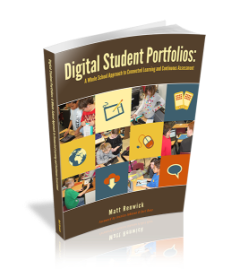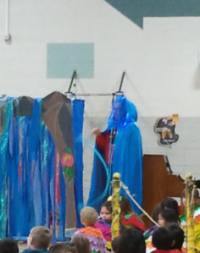disrupt, \dis-ˈrəpt\, verb: to cause (something) to be unable to continue in the normal way : to interrupt the normal progress or activity of (something) – Merriam-Webster Dictionary

Disruptive Innovations in Reading Research and Practice by Susan B. Neuman and Linda B. Gambrell (Reading Research Quarterly, January/February/March 2-15)
The editors of this literacy research journal explore the concept of “disruption”. They compare the corporate world’s definition of this idea, which focuses on the bottom line, with education’s understanding, which “is to promote lifelong learning”. Neuman and Gambrell do not see education as a problem that needs fixing, but rather encourage subtle changes that can agitate the status quo. Both feel this is a necessary step in teaching reading and writing today.
If we are to participate – no less compete – in a global society, we will need to open the door to a number of disruptions in reading education.
Neuman and Gambrell highlight certain areas that are ripe for disruption.
- Bilingual Education (Disruption): Monolingual Education (Disruptee)
- Universal Full-Day Kindergarten (Disruption): Hit-or-Miss Full-Day Kindergarten (Disruptee)
- Multiple Literacies (Disruptor): Traditional Literacy (Disruptee)
- Online Teacher Education (Disruption): Brick-and-Mortar Teacher Education Programs (Disruptee)
They close their editorial by calling on the reader to “use this notion of disruption to our advantage”.
To BYOD or not to BYOD? by Aileen Hower and Tom Whitford (Reading Today, January/February 2015)
Two educators square off on the promise and problems with bring-your-own-device (BYOD) initiatives. Hower sees lots of possibilities, including increased student engagement, quick access to resources, and easy ways to assess understanding through apps such as Socrative.
In contrast, Whitford finds pitfalls in BYOD initiatives. For instance, how do schools address lack of access to devices and wireless for some students? Also, the management of multiple devices can be daunting for a teacher. What’s interesting is that neither Hower and Whitford denounce BYOD as a learning initiative, making the title somewhat misleading.
B.C. report cards enter the age of social media by Tracy Sherlock (Vancouver Sun, December 5, 2015)
Elementary teachers across British Columbia are using a web tool called FreshGrade to capture and share student learning as it happens. Parents get a notification on their smartphone or tablet when their son or daughter has a new artifact entered in their online portfolio. One teacher loves this aspect.
They (students) will do something that they’re so proud of and they will say to me, ‘Can you put this on my portfolio so mommy and daddy can see it?’ I can do it instantaneously — I push ‘share’ and the parents get it right away. The communication with the parents is amazing — they understand because they can see it.
The ability for students and teachers to upload video, audio, images, or text in real time is also supported by school leadership. Antonio Vendramin, elementary principal, questions the traditional grading structure now that many of his teachers are using online portfolios.
I think this is the direction we need to go — we need to make reporting less of an event. We need to make sure this communication with parents is happening as we go, not just three times per year.
 Interested in learning more about online portfolios? Check out my book Digital Student Portfolios: A Whole School Approach to Connected Learning and Continuous Assessment. It is on sale through February – $5 off when you use the code PASSION5 during checkout. You can also join our Google+ Community on the topic. There are over 300 people to share resources and connect with on authentic assessment.
Interested in learning more about online portfolios? Check out my book Digital Student Portfolios: A Whole School Approach to Connected Learning and Continuous Assessment. It is on sale through February – $5 off when you use the code PASSION5 during checkout. You can also join our Google+ Community on the topic. There are over 300 people to share resources and connect with on authentic assessment.
K-12 MOOCs Must Address Equity by Norman Eng (Education Week, February 5, 2015)
A professor of education in New York questions the effectiveness of massive open online courses, or MOOCs. While these online learning platforms have seen some success at the university level, there are two big reasons why they are ineffective at the K-12 level. First, the delivery of information is often lecture-based, no difference than a lecture delivered in a physical classroom. Second, disadvantaged students may lack broadband access to the Internet at home. Eng sums up the issue well at the end of his commentary.
How you use technology is more important than the technology itself.
e-text and e-books are changing the literacy landscape by Bridget Dalton (Phi Delta Kappan, November/December 2014)
This article focuses on “the array of multimedia and multimodal devices and applications that promise to help struggling readers and engage all learners.” Dalton, a literacy professor, applies the Universal Design for Learning (UDL) framework to ensure that digital curricula and texts address learners’ needs and explore the possibilities of enhancing student fluency and comprehension.
Dalton highlights a number of benefits of using e-books with learners, such as interactive vocabulary software embedded in the digital texts to help the reader make meaning of a challenging word. She also offers five clear steps for selecting and teaching with e-books and e-texts:
- Use e-text with audio narration to provide access to the general education curriculum and grade-level text.
- Select e-books with meaningful enhancements for vocabulary and comprehension.
- Teach students how to use e-text features.
- Create an e-reader community.
- Use professional development and get technical assistance.
The author believes that using digital tools for reading and communicating should be more than just an enhancement to the school day. “Every child should be reading e-books as part of his or her literacy curriculum.”
Putting the puzzle together…

Yesterday I was a waterfall. That is, I portrayed one for my students and school during a performance by Opera for the Young. When I wasn’t twirling a banner to simulate cascading water, I was sitting next to Vince, the accompanist for the singers.
At first glance, you wouldn’t really notice anything different as he played. But from my vantage point, the implementation of the iPad to hold his music was more than just not having to carry around songbooks. For instance, the app forScore saved all of his music in Google Drive. Also, Vince could annotate right on the sheet music, such as reminders during the performance to cue me as to when to stand up and perform.
Even more amazing were the pedals by his feet. He could press this device that was connected to his iPad via Bluetooth, and it would turn the digital page of music, half sheet at a time. There was no more quick gestures to flip a physical page. After the show, Vince shared that there was no way he could go back to physical sheet music. He was a better pianist because of this innovation. Disruptor = digital text; Disruptee = traditional publishers.
Can BYOD or MOOCs make this claim, that the introduction of their technologies has disrupted learning to the point of no going back? Apparently not yet. I took a MOOC myself last summer and can concur with what Norman Eng shared. As for BYOD, these initiatives vary in their implementation from school to school. Unfortunately, too many decisions to allow all students to bring their own devices came about because administrators got tired of being the cell phone police in their schools.
I think educators have been more discriminating about effective use of technology in classrooms than technologists and corporations give them credit for. This might be a disappointment for them, as they may view schools as antiquated and a market, respectively. When we have the ability to determine that e-books and online portfolios have a more positive influence on achievement than MOOCs and BYOD, we give the control of learning back to our students and ourselves. We can decide what’s worth disrupting.
One response to “DisruptEd”
Reblogged this on Reading By Example and commented:
Is education ripe for disruption? It depends on which areas and who you ask. While eBooks and online portfolios have gained a strong foothold in schools, MOOCs and BYOD continue to have their ups and downs in the K-12 environment. Why do some innovations make an impact on student learning and others do not? Consider sharing your response to this question in the comments.